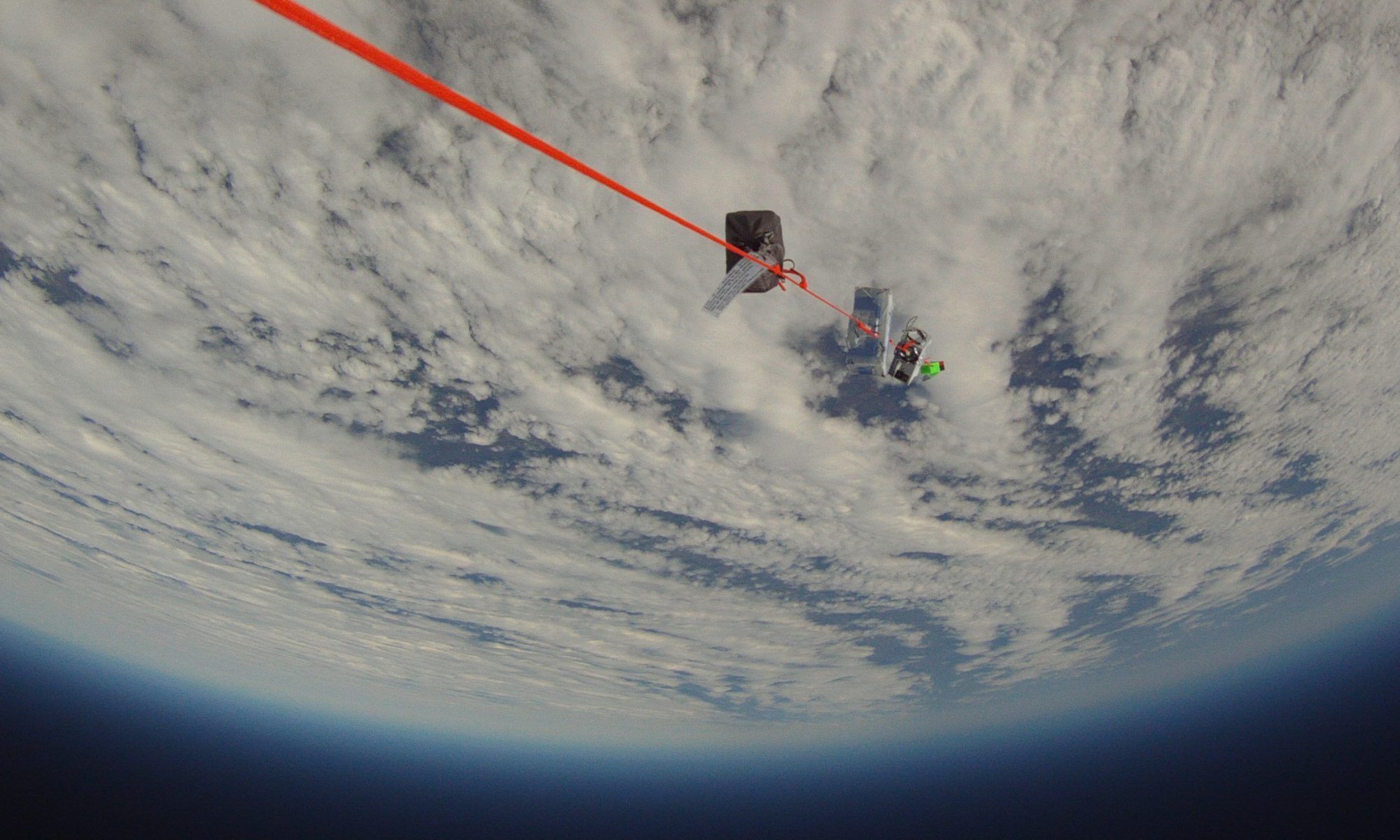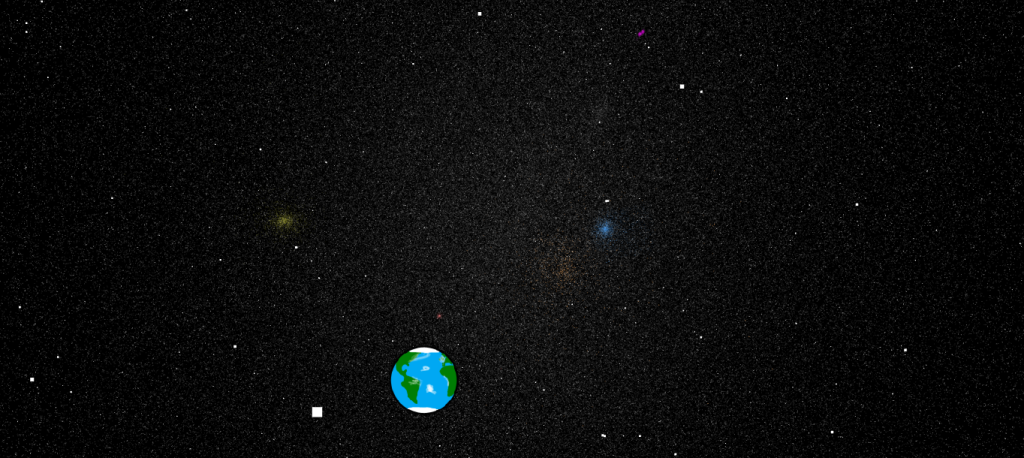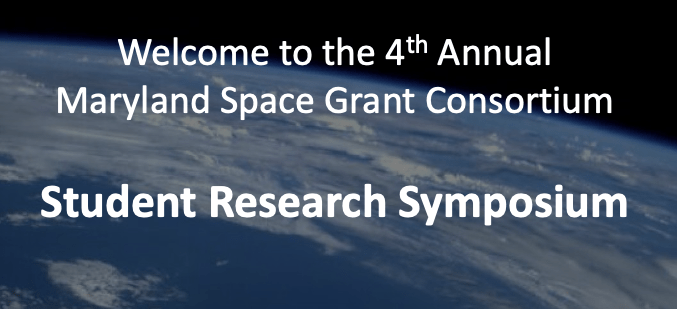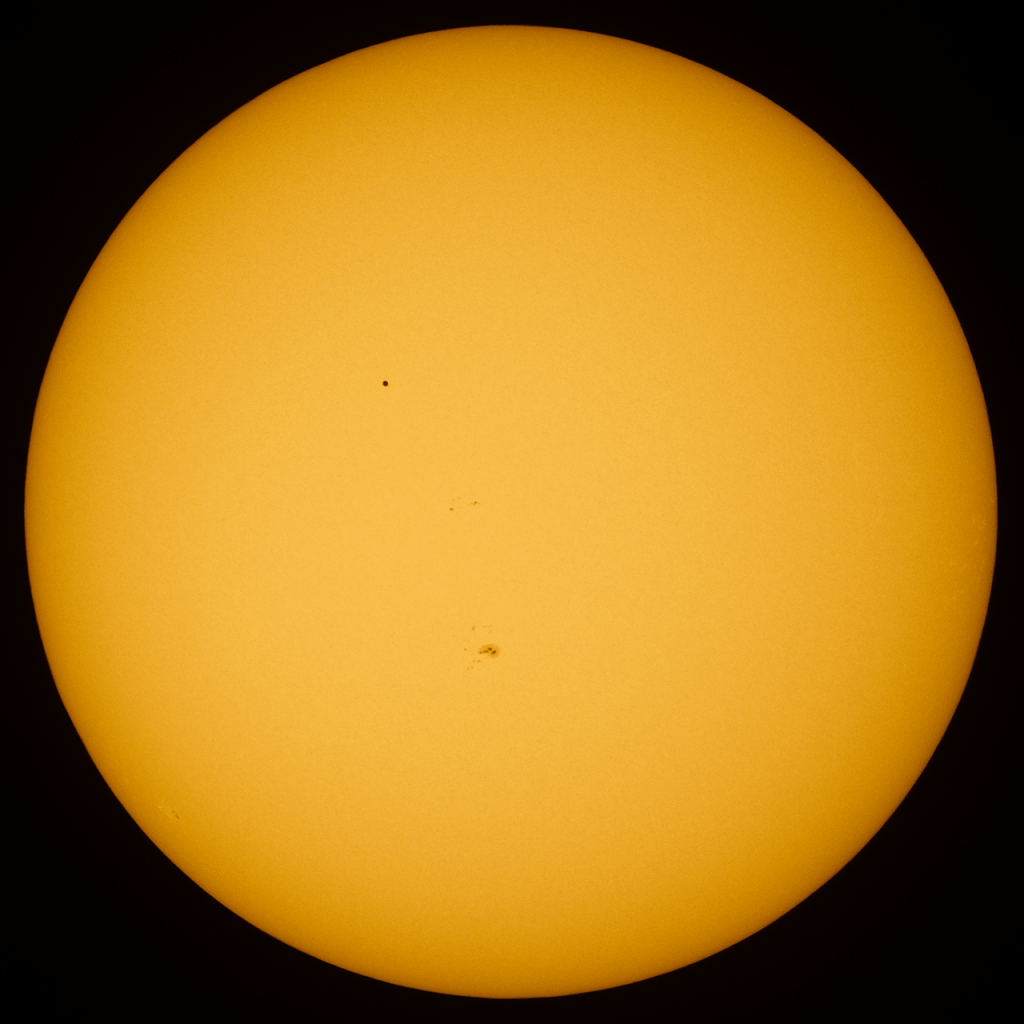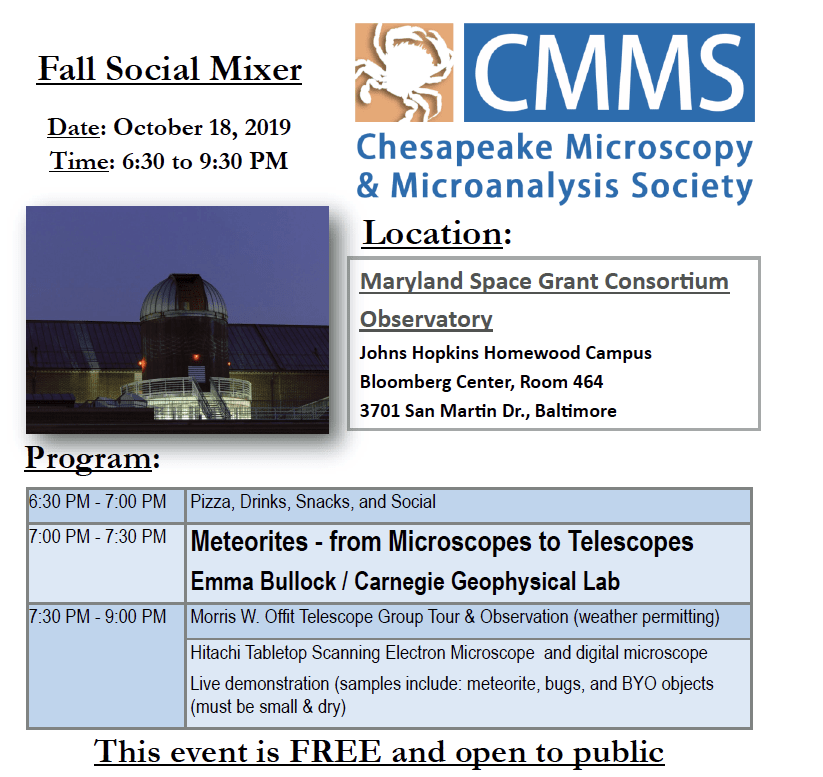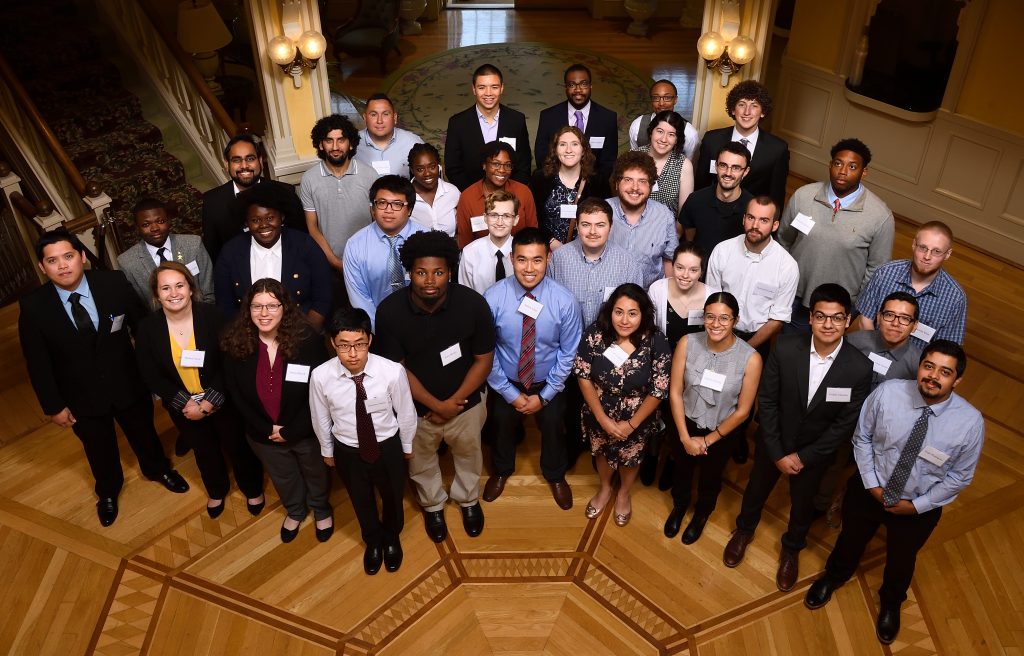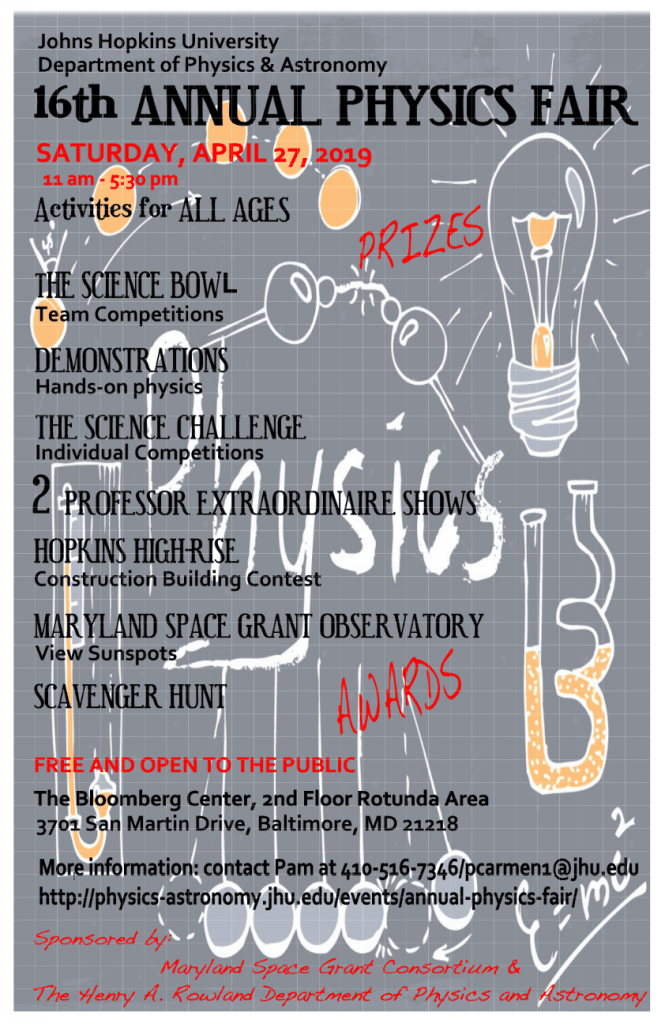The 2020 MDSGC Student Research Symposium was held via Zoom on Friday, August 7, showcasing presentations by student interns and researchers working at sites across Maryland.
This year’s cohort of presenters represented diverse institutions, including: Capitol Technology University, Goddard Space Flight Center, Hagerstown Community College, Kennedy Space Center, Morgan State University, Towson University, University of Maryland Baltimore County, University of Maryland College Park, and University of Maryland Eastern Shore. We congratulate our students on a successful summer, under trying circumstances, and look forward to seeing more of their work in the future!
The full program follows. This page may be updated to include links to PDF of slides as final presentation versions are submitted.
2020 MDSGC (Virtual) Student Research Symposium Program
9:30 a.m.
Zoom access verification and sound checks for presenters.
Session 1
10:00 a.m.
Introductory Remarks — Matt Collinge, MDSGC Deputy Director
10:10 a.m.
Robotic Mining Competition – Izzeldin Abuelgasim (UMES)
The main objective of this presentation is to break down the process that was taking place over the summer on this project. Also, to give a clear understanding of the Robotic Mining Competition project and persuade others to join the cause.
10:20 a.m.
Measuring Fundamental Constants with Torsional Balances – Sean Garnett (Towson University)
We report on experiments with a Coulomb balance and Cavendish balance which we hope to integrate into the physics curriculum at Towson University. The Coulomb balance measures the electrostatic force between two charged spheres, while the Cavendish balance measures the gravitational force between two heavy masses. We have been able to confirm the 1/r^2 behavior of Coulomb’s law, after correcting for a weakening effect at small distances due to mutual polarization of the test charges. We are now taking our first data with the Cavendish balance. Both experiments are challenging, but comparable in difficulty with some of the more advanced components of our existing Intermediate Laboratory course.
10:30 a.m.
What Goes Up Must Come Down – Charis Houston (Capitol Technology University)
The presentation focuses on the activity created for the USNA STEM Center. The activity focuses on basic cybersecurity principles in combination with satellites. Students have to build, launch, and successfully recover a model satellite.
10:40 a.m.
Remote Internship: Robotics, Sensors, Coding, and Pollution Data Analysis related to Covid-19 – Courtney Davidson (UMCP)
My remote internship was split into two projects; robotics and pollution research in correlation to the coronavirus lockdown. The GoPiGo3 robot was the main platform for exposure to robotics and coding languages, specifically Python. Using Proportional Integral Derivative (PID) control I experimented with the line follower sensor to optimize its path tracking. Through web content analysis I looked at pollution data centered around the lockdown period from the first have of this year. This was done in order to explore the reasons behind clear skies that were seen in typically polluted cities.
10:50 a.m.
A Model for Intergalactic Dust and its Impact on the Extragalactic Background Light – Maegan Jennings (Towson University)
Observations of quasar reddening demonstrate that extinction by dust in the intergalactic medium is significant at optical wavelengths, but the impact of this extinction on the spectral intensity of the extragalactic background light (EBL) has not yet been assessed in a quantitative way. We use an interstellar dust extinction model of Weingartner and Draine and combine this with simple but physically reasonable expressions for dust evolution to arrive at an intergalactic dust model with two adjustable parameters. The resulting opacities closely match observational constraints from Imara and Loeb at near-optical wavelengths. We convolve this intergalactic dust model with a simple EBL model (described elsewhere in this meeting) to determine that optical EBL intensity is reduced by approximately 3% due to intergalactic dust. The “missing” light is of course shifted to longer wavelengths. Nevertheless, this result is a partial vindication for H.W.M. Olbers and his predecessor, J.P.L. de Cheseaux, who were the first to speculate that an absorbing medium might help to explain the darkness of the night sky.
11:00 a.m.
Design and Simulation of the Different Nozzle Types for Liquid Propellant Rocket Engine – Diego Torres-Siclait (UMBC)
In a liquid propellant rocket engine, mixing and combustion of liquid propellant and oxidizer occurred in the combustion chamber. Based on Newton’s third law, the nozzle increases velocity of hot products into ultrasonic velocity and thrust. Thus, the nozzle design becomes one of the most critical parts to increase thrust and maximize apogee of the liquid fuel rocket. This study is to investigate the performance of different nozzle types by designing, modelling, and simulating them using current mathematical, CAD, and Computational Fluid Dynamics softwares. Results indicated that nozzle design significantly affected velocity and temperature in the combustion chamber. The dual-bell nozzle was proved as a feasible design like conical and bell nozzles.
11:10 a.m.
Nature Inspired Self-Cleaning Surfaces – Grace Cunningham (Hagerstown Community College & WVU)
In this presentation, I will be explaining my task of studying Hydrophobic surfaces and my results. With a number of uses, we find that they can also be mimicked for other uses. Because of their micro-structures, we also find that these surfaces are oleophilic.
11:20 a.m.
Designing a Pan & Tilt Camera/Light System
for Use on On-Orbit Satellite Servicers – Justyn Bunkley (UMBC)
On-Orbit Satellite Servicers are an up-and-coming technology in the field of aerospace. These devices will someday go on to repair and restore many operational satellites in low Earth orbit and beyond. One key component to the success of these servicers is a reliable camera system. While current models use one or more stationary cameras, there are limitations to this design. The person controlling the servicer needs to have a wide field of view of the satellite. Designing a pan and tilt camera/light system that can be mounted on the servicers would overcome these limitations, and significantly increase its overall performance. Using motors, sprockets, rods, and sprocket chains, this system could pan two cameras and two miniature lights 60 degrees left and right, as well as 90 degrees up and down. This would allow the controller to have an enhanced field of view on the satellite using a single camera system.
11:30 a.m.
Early Work on Extra Dimensions by Yuri Rumer – Gregory Kuri (Towson University)
I discuss the life and work of theoretical physicist Yu B. Rumer, a founder of quantum chemistry who also made pioneering contributions to unified field theory based on the idea of extra dimensions (Kaluza-Klein theory). His work remains little known in the West because it was done in captivity in the Soviet gulag, and never translated into English. I summarize some of the key points from our translation of the first two of these articles and discuss the relevance of Rumer’s ideas to modern physics.
11:40 a.m.
MDSGC Internship Review: Dusty Plasma Laboratory – Keith Gorschboth (UMBC)
This is a review of the ongoing research at the DPL or dusty plasma laboratory. The DPL is working on a new high energy pulsed plasma experiment for the purpose of achieving nuclear fusion. This presentation reviews my work in designing and simulating the circuitry that the experiment will be using.
11:50 a.m.
CASALS Lidar Instrument Digital Design – Harun Gopal (UMCP)
Novel advancements in lidar technology are being developed to aid in the efficient collection of topographical data. Concurrent Artificial Intelligence Spectrometry and Adaptive Lidar Systems (CASALS) presents one such novel technique. This project seeks to aid the development of CASALS by demonstrating, through a proof of concept, the feasibility of the proposed digital design. A Tektronix 710 arbitrary waveform generator (AWG) and a National Instruments(NI) PXI-8800 chassis equipped with PXIe-5764 digitizer module, PXI-6683H GPS and timing module, and PXIe-8267 storage module replicated multiple components inherent to the digital design and allowed full prototyping of the required sections. The AWG functioned to sufficiently replicate a single stream 8:1 multiplexed input waveform so to test the functionality of the final prototype. A field programmable gate array chip (FPGA chip) housed within the NI PXI-8800 chassis controlled the operation of the prototype and was programmed through LabVIEW, a visual coding language, to control the functions of the prototype. The prototype has successfully digitized an input signal; displayed the signal; collected time, velocity, and location data; and stored all the relevant information in a specified data format onto a storage module. Progress was made on effective data reduction and isolation, however wasn’t perfected. The results of this project suggests that the foundation of CASALS digital design has been proven to work, however other avenues of prototyping such as implementing a more complex data storage format to allow for additional types of data to be stored would be beneficial to make a final determination on this subject.
12:00 p.m.
Session 2
12:15 p.m.
Making a NASA Logo using Javascript – Ashley Afueh (UMES)
Within the internship, I learned how to code JavaScript moderately. I utilize this skill to recreate the NASA logo using JavaScript.
12:25 p.m.
Calibration and Theoretical Modeling of a Rolling Railgun -Hannah Lee Clark & Taylor Pettaway (Towson University)
We report on a “rolling railgun” demonstration that we are developing as a lab activity for calculus-based introductory electromagnetism classes at Towson University. Current from a 9V battery is passed through an iron axle connecting two cylindrical neodymium magnets which serve as wheels. If properly oriented, the magnetic field of these magnets exerts a continuous torque on the axle, propelling the “rolling railgun” along tinfoil rails at accelerations that can approach 1 g. We calculate this acceleration theoretically and find reasonable agreement with experimental measurements. Animations included!
12:35 p.m.
COVID-19 Predictive Model – Shanice Nurse (UMES)
The staggering death toll related to the COVID-19 pandemic has shown a steady decrease in Maryland. Providing a general precise projection about deaths related to COVID-19 will allow citizens to be aware and more cautious in this pandemic. There are different variables that influence the pandemic and response which will assist with the projection data in the forecasting model. The datasets used in this forecasting model is derived from the Institute for Health Metrics and Evaluation, which forecast data that continues to be refined as the pandemic evolves. This COVID-19 Forecasting Model is intended to assist officials in making decisions about investing in testing, tracing and isolation. Also, individuals will be able to utilize this information which should guide their behavior regarding social distancing.
12:45 p.m.
Design and Analysis of a Liquid Propellant Rocket (LPR) — Alexis Burris (UMCP)
Morgan State University is developing a single-stage liquid-fueled rocket that will launch to an altitude of 13,000 feet, in the year 2021. The goal this summer was to create 3D models and 2D drawings in CAD for the full assembly of the rocket. The team divided the rocket into sub-components to properly design each component. The nose cone, airframe, boat tail, and fins were all designed separately to fully optimize every component to reduce drag, pressure, temperature, and many other factors. Each sub-component was carefully designed using multiple software tools to prove the effectiveness of each component.
12:55 p.m.
Dual Multi Streamtube Model for Vertical Axis Wind/Water Turbines – Kimberly Frost (CTU & UMBC)
The project focused on the development of a low order Dual Multi-Stream Tube (DMST) model in Matlab that provides accurate data on the power output and efficiency of Vertical Axis Wind Turbines (VAWTs). The model was used to corroborate Computational Fluid Dynamic (CFD) data results for a Hybrid-Darrieus-Modified-Savonius (HDMS) turbine design.
1:05 p.m.
Astrophysical applications of the gravito-electromagnetic approximation within general relativity – Ozzy Weinreb (Towson University)
Einstein’s field equations of general relativity reduce in the weak-field, low-velocity limit to a set of four differential equations that are almost identical to Maxwell’s equations for the electromagnetic field. These equations govern the behavior of gravito-electric and gravito-magnetic fields sourced by mass and mass currents. We explore some of the implications in a general way, focusing on dimensional arguments and order-of-magnitude estimates to assess the extent to which astrophysical phenomena in extreme environments (such as jets and accretion disks) can be understood, at least in part, as gravitational analogs of the familiar laws of Ampere, Biot-Savart, Faraday and Lenz, and even as real-world examples of “gravitational transformers” in action.
1:15 p.m.
Feasibility Study for Suspended Aerobic Membrane Bioreactor for Wastewater Treatment in Space – Mattie Hoover (UMGC)
Over the summer 2020 semester, I worked as a NASA intern in the UB-G Exploration Research and Technology Directorate under mentor Dr. Luke Roberson. The goal of the internship was to develop a feasibility study for a new, competitive solution for wastewater treatment that could be utilized for future space exploration. While taking into account conditions unique to interplanetary travel and colonization, the specific idea being justified was a Suspended Aerobic Membrane Bioreactor (SAMBR) to treat low strength wastewater in three mains forms: humidity condensate, urine, and hygiene water. The feasibility study for a SAMBR system relied on the discovery and recording of supporting literature gathered by the intern, which would provide information on what current technology is being utilized for wastewater treatment, details and understanding for how the SAMBR should be designed, and critical foundation material for justifying the development of the SAMBR system.
Each week, the intern would compile and present noteworthy information gathered from peer-reviewed scientific research articles which supplied the background for the development of the SAMBR system. Utilizing systems currently in place on Earth for wastewater treatment, specifically the Modified Ludzack-Ettinger (MLE) process, the team was encouraged to develop a dual-chamber system for treating wastewater in space. Further research into biological systems and interactions supported the installation of a hybrid bacteria-algae biofilm, a system known as Algal-bacterial Symbiosis (ABS), which would grow in a Moving Bed Biofilm Reactor (MBBR). Through utilizing the ABS, the bioreactor would be able to self-sustain homeostasis and, therefore, eliminate the need for human intervention via the removal of excess biomass. The Moving Bed Biofilm Reactor (MBBR) is a system which utilizes biocarriers that grow suspended biofilms; while suspended, the wastewater is allowed unlimited access to the biofilms which will remove all waste products from the wastewater through biological processes and produce potable water as the end product. Ideally, this system will be fully developed and tested for utilization in the Artemis mission; if successful, this system will ensure safe and reliable interplanetary travel for possible colonization of the moon.
1:25 p.m.
Kilobotics – Mya Thompkins (Morgan State University / UMCP)
This project involved programming a kilo-bot swarm of micro-robots via online simulation, analyzing emergent behavior of individual robots to create a complex system following simple rules.
1:35 p.m.
Braneworld Dark Matter and the Diffuse Gamma-Ray Background – William Mann (Towson University)
We revisit dark-matter candidates that arise in Large Extra Dimensions (LED) or “braneworld” theories, in which additional spacelike dimensions are accessible to gravity, but not to the other interactions of the standard model. As a result, gravitons in these theories are able to carry energy “off the brane” and into the higher-dimensional bulk. Constraints can be placed on the number and size of these dimensions through limits on energy lost from supernovae cores, which eventually contributes to the diffuse gamma-ray background (DGRB). We use new observations of the DGRB from the Fermi-LAT satellite to update existing constraints on the theory.
1:45 p.m.
MDSGC offers our sincere congratulations to our student presenters, a huge thanks to our internship mentors, collaborators, and supporting staff, and our hope that all attendees have enjoyed and learned from today’s presentations!

